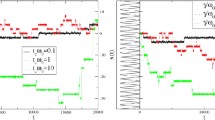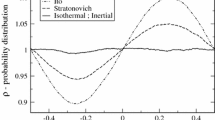Abstract
Our interest goes to the behavior of a tracer particle, accelerated by a constant and uniform external field, when the energy injected by the field is redistributed through collision to a bath of unaccelerated particles. A non equilibrium steady state is thereby reached. Solutions of a generalized Boltzmann-Lorentz equation are analyzed analytically, in a versatile framework that embeds the majority of tracer-bath interactions discussed in the literature. These results—mostly derived for a one dimensional system—are successfully confronted to those of three independent numerical simulation methods: a direct iterative solution, Gillespie algorithm, and the Direct Simulation Monte Carlo technique. We work out the diffusion properties as well as the velocity tails: large v, and either large −v, or v in the vicinity of its lower cutoff whenever the velocity distribution is bounded from below. Particular emphasis is put on the cold bath limit, with scatterers at rest, which plays a special role in our model.






Similar content being viewed by others
References
Lorentz, H.: In: KNAW, Proceedings, vol. 7, pp. 1904–1905 (1905)
Piasecki, J., Wajnryb, E.: J. Stat. Phys. 21(5), 549 (1979)
Olaussen, K., Hemmer, P.: J. Phys. A, Math. Gen. 15, 3255 (1982)
Piasecki, J.: Am. J. Phys. 61, 718 (1993)
Martin, P., Piasecki, J.: J. Phys. A, Math. Gen. 40, 361 (2007)
Piasecki, J.: J. Stat. Phys. 30(1), 185 (1983)
Résibois, P., Mareschal, M.: Physica A 94(2), 211 (1978)
Piasecki, J.: Phys. Lett. A 114(5), 245 (1986)
Gervois, A., Piasecki, J.: J. Stat. Phys. 42(5), 1091 (1986)
Eder, O., Posch, M.: J. Stat. Phys. 52(3), 1031 (1988)
Martin, P., Piasecki, J.: Europhys. Lett. 46, 613 (1999)
Piasecki, J., Soto, R.: Physica A 369(2), 379 (2006)
Alastuey, A., Piasecki, J.: J. Stat. Phys. 139(6), 991 (2010)
Gradenigo, G., Puglisi, A., Sarracino, A., Marconi, U.M.B.: Phys. Rev. E 85, 031112 (2012). doi:10.1103/PhysRevE.85.031112
Puglisi, A., Sarracino, A., Gradenigo, G., Villamaina, D.: Granul. Matter (2012). doi:10.1007/s10035-012-0312-9
Fiege, A., Grob, M., Zippelius, A.: Granul. Matter (2012). doi:10.1007/s10035-011-0309-9
Candelier, R., Dauchot, O.: Phys. Rev. E 81, 011304 (2010). doi:10.1103/PhysRevE.81.011304
Maxwell, J.: Philos. Trans. R. Soc. Lond. 157, 49 (1867)
Brilliantov, N., Pöschel, T.: Kinetic Theory of Granular Gases. Oxford Graduate Texts (2004)
Ernst, M., Trizac, E., Barrat, A.: J. Stat. Phys. 124, 549 (2006)
Santos, A., Dufty, J.: Phys. Rev. Lett. 97(5), 58001 (2006)
Montanero, J.M., Santos, A.: Granul. Matter 2, 53 (2000)
Piasecki, J., Talbot, J., Viot, P.: Physica A 373, 313 (2007)
Hahn, K., Kärger, J., Kukla, V.: Phys. Rev. Lett. 76, 2762 (1996). doi:10.1103/PhysRevLett.76.2762
Ernst, M.: Phys. Rep. 78, 1 (1981)
Krapivsky, P.L., Sire, C.: Phys. Rev. Lett. 86, 2494 (2001)
Piasecki, J.: J. Stat. Phys. 24(1), 45 (1981)
Visco, P., van Wijland, F., Trizac, E.: Phys. Rev. E 77(4), 041117 (2008)
Talbot, J., Viot, P.: J. Phys. A, Math. Gen. 39, 10947 (2006)
Bird, G.: Comput. Math. Appl. 35(1–2), 1 (1998)
Ernst, M., Brito, R.: Phys. Rev. E 65(4), 040301 (2002)
Dean, D., Majumdar, S.: J. Stat. Phys. 124(6), 1351 (2006)
Ben-Avraham, D., Ben-Naim, E., Lindenberg, K., Rosas, A.: Phys. Rev. E 68(5), 050103 (2003)
Wannier, G.: Phys. Rev. 83(2), 281 (1951)
Gasper, G., Rahman, M.: Basic Hypergeometric Series, vol. 35. Cambridge University Press, Cambridge (1990)
Bateman, H., Erdélyi, A., Project, B.M.: Higher Transcendental Functions. Krieger, Melbourne (1981)
Gordon, B., Mcintosh, R.: J. Lond. Math. Soc. 62(2), 321 (2000)
Leipnik, R.: J. Aust. Math. Soc. Ser. B, Appl. Math 32(03), 327 (1991)
López-García, M.: Theory Probab. Appl. 55, 303 (2011)
Stieltjes, T., Dijk, G.: Collected Papers/Oeuvres Completes. Springer, Berlin (1993)
Bruijn, N.D.: Indag. Math. 15, 449 (1953)
Résibois, P., De Leener, M.: Classical Kinetic Theory of Fluids. Wiley, New York (1977)
Acknowledgements
We would like to thank A. Alastuey, A. Burdeau, S. Majumdar, J. Talbot, and P. Viot for useful discussions.
Author information
Authors and Affiliations
Corresponding author
Appendix: Computation of the Diffusion Coefficient
Appendix: Computation of the Diffusion Coefficient
Let us define the velocity autocorrelation function Γ(t) as
where 〈 . 〉 denotes the mean over the stationary distribution f ν (v) and v(t) is the velocity of a given realization of the tracer at time t. A standard relation [6, 42] connects Γ(t) to the diffusion coefficient

where use was made of the fact that both v(0) and v(∞) are sampled according to f ν (v), and it was assumed that the above limits exist. In a derivation similar to the one used in [42], this function Γ(t) is expressed as
where F ν (v,t|v 0) is the conditional velocity distribution of the tracer at time t knowing it had velocity v 0 at time 0, i.e. it is the time-dependent distribution F ν (v,t) with the initial condition F ν (v,0)=δ(v−v 0). We may thus define the auxiliary function
which fulfills the initial condition
and
Due to the linearity of the Boltzmann-Lorentz equation, N(v,t) follows the same equation as F ν (v,t) as can be seen from Eq. (89). Therefore, the determination of Γ(t) using (91) amounts to computing the integral and first moment of the solution of the Boltzmann-Lorentz equation with the non-physical initial condition (90). As this equation conserves the normalization,
thus
Finally, if ν=0, this time-dependent first moment can be computed directly from the Boltzmann equation
The first term on the right-hand side vanishes, while \(v_{1}' - v_{1} = (a-1) \,(v_{1} - v_{2})\) and therefore
from which the diffusion coefficient follows
We have thus related D to the variance of the tracer stationary velocity distribution in the case of Maxwell particles with an arbitrary bath.
Furthermore, the approach can be generalized to higher dimensions, where the collision law reads
so that Eq. (94) becomes

Then, if we define e 12 the unit vector along (v 2−v 1), θ the angle between \(\hat{\sigma}\) and e 12, and \(\hat{\varOmega}\) the solid angle
where A d is the area of the d-dimensional unit hypersphere. We may then compute the first and second moments: letting g=g e x
hence
which gives the following relation for the diffusion coefficient in d dimensions in a bath with unit temperature:
Rights and permissions
About this article
Cite this article
Barbier, M., Trizac, E. Field Induced Stationary State for an Accelerated Tracer in a Bath. J Stat Phys 149, 317–341 (2012). https://doi.org/10.1007/s10955-012-0591-x
Received:
Accepted:
Published:
Issue Date:
DOI: https://doi.org/10.1007/s10955-012-0591-x




